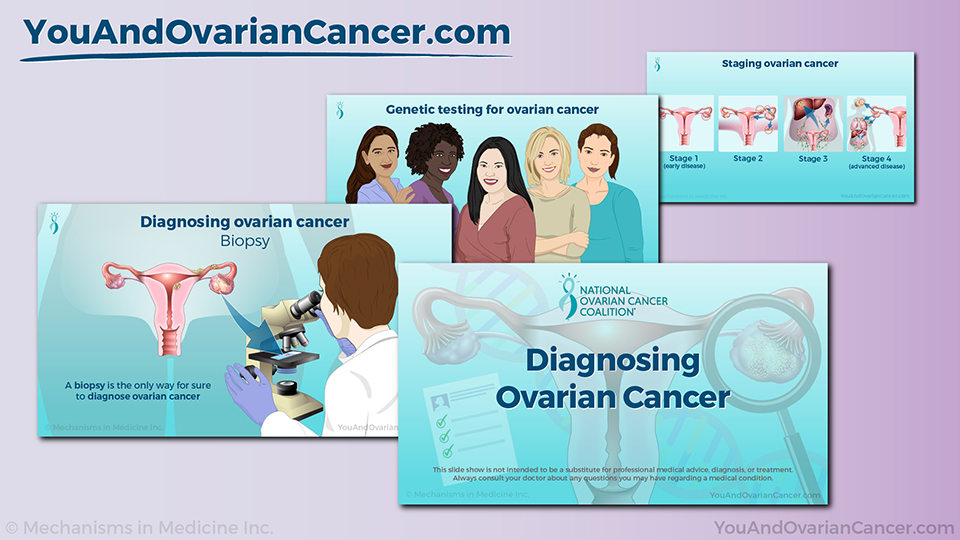











Slide Show - Diagnosing Ovarian Cancer
Your feedback is important to us! We will use your feedback to develop future areas of content about ovarian cancer which will help other patients, caregivers and families.
























Diagnosing Ovarian Cancer
*Please note: This slide show is not intended to be a substitute for professional medical advice, diagnosis, or treatment. Always consult your doctor about any questions you may have regarding a medical condition.
Why is ovarian cancer challenging to diagnose?
Ovarian cancer is often not diagnosed until after it's begun to spread beyond the ovary because:
Is there a screening test for ovarian cancer?
Screening tests are used to detect cancer before it shows any symptoms. Today, there is no screening test that accurately detects ovarian cancer.
Is there a screening test for ovarian cancer?
Women with ovarian cancer may have high blood levels of a protein called CA-125.
But conditions like pregnancy, fibroids, or your monthly period can also cause higher than normal blood levels of CA-125. This means that CA-125 testing is not a reliable way to screen for ovarian cancer.
Is there a screening test for ovarian cancer?
A test called transvaginal ultrasound can show a mass in an ovary but can't tell if the mass is cancer.
Researchers are working on developing an accurate screening test for ovarian cancer.
Important hereditary genetic risk factors for ovarian cancer
Some women are at higher risk for ovarian cancer due to inherited genetic mutations that can be passed on by either parent. Even fathers can pass these on to daughters.
Important hereditary genetic risk factors for ovarian cancer
Inherited mutations in genes called BRCA1 and BRCA2 are the most common mutations that increase risk for both ovarian cancer and breast cancer.
Mutations in BRCA1 and BRCA2 genes are 10 times more common in women who have Ashkenazi Jewish ancestry.
Important hereditary genetic risk factors for ovarian cancer
Mutations in other, less common genes may also increase risk for ovarian cancer.
Lynch Syndrome, also known as HNPCC, is another genetic condition that can run in families. Lynch Syndrome increases risk for several cancers, including colon cancer, ovarian cancer, and endometrial cancer.
Knowing and sharing your family medical history – on both sides of the family – is an important way to help identify genetic conditions that increase cancer risk.
Genetic testing for ovarian cancer
Whether or not you have a family history of cancer, all women diagnosed with ovarian cancer should have access to genetic testing to see if it's a hereditary condition.
Knowing you have a genetic mutation may impact your treatment options.
For other family members who are diagnosed with a hereditary condition, tests to monitor for cancer can help reduce their risk.
Diagnosing ovarian cancer
Physical exam and health history
If ovarian cancer is suspected, your doctor will:
Diagnosing ovarian cancer
Gynecologic oncologist
Some tests look for high levels of substances in the blood called biomarkers that may indicate cancer. But conditions that are not cancer can also cause high levels of these substances.
If any of your blood test results suggest that you might have ovarian cancer, you should see a gynecologic oncologist.
Diagnosing ovarian cancer
Imaging tests
Your doctor should also order imaging tests, such as CT, PET or MRI. These tests can show if there's a growth but can't tell for sure if it's cancer.
Diagnosing ovarian cancer
Biopsy
A biopsy is the only way for sure to diagnose ovarian cancer. This involves removing tissue and looking at it under a microscope. A biopsy may be done before surgery to get a diagnosis, or during surgery when removing a mass.
Staging ovarian cancer
Staging describes the extent of cancer in the body. This helps with choosing the best treatment.
Like most cancers, ovarian cancer has four main stages.
Staging ovarian cancer
TNM system
The TNM system provides more information about the cancer by answering three questions.
Grading ovarian cancer
Grading describes how the cancer cells look under a microscope and how fast they are growing.
The microscopic pictures will also define the cancer cell type. There are many different types of ovarian cancer cells that behave differently.
Knowing your cancer's stage, grade and cell type will help your team plan the best treatment for you.
Talking with your healthcare team
If you have any questions about what your cancer stage or grade means, ask your doctor or another member of your healthcare team to explain it to you.
References
Your feedback is important to us! We will use your feedback to develop future areas of content about ovarian cancer which will help other patients, caregivers and families.












This educational activity has been developed by the National Ovarian Cancer Coalition in collaboration with Mechanisms in Medicine Inc.
This activity is supported by educational grants from:
Alkermes plc, AstraZeneca Pharmaceuticals LP, Clovis Oncology, Inc., Eisai Inc., Foundation Medicine, Inc., Genentech, a Member of the Roche Group, GSK, ImmunoGen, Inc., Merck & Co, Inc., Novartis, Novocure Inc., Pfizer, Inc.
Copyright © Mechanisms in Medicine Inc. All rights reserved. Mechanisms in Medicine Inc. does not provide medical advice, diagnosis, or treatment.
This website is part of the Animated Patient® series developed by Mechanisms in Medicine Inc., to provide highly visual formats of learning for patients to improve their understanding, make informed decisions, and partner with their healthcare professionals for optimal outcomes.